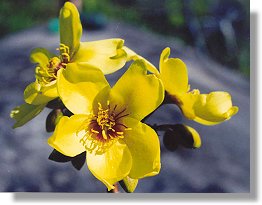Kapok and red-winged parrot
 |
Kapok (Cochlospermum gillivraei) |
| |
The kapok (Cochlospermum gillivraei) could well be considered the floral emblem of Magnetic Island. During the mid-to-late dry season (August-October) when in full flower, it dominates the rocky headlands between the bays and rocky granite ridges on the higher slopes of the Island.
The kapok is a small tree, usually 3-8 m in height, found in coastal areas on granite ridges and in open forest on well-drained sandy soils. The kapok is deciduous, losing its maple-shaped leaves after the wet as the dry season sets in. It has a bright, smooth silvery-grey bark, which contrasts with the displays of bright yellow flowers produced on the end of the branches in the mid-to-late dry season. The bright yellow flowers are edible and are used by Island eateries to make garnishes for spring salads.
The bright yellow flowers are followed by a large, green apple-shaped fruit. As this dries it turns to a woody brown colour and splits to release black seeds covered in a cotton-like fibre. These cotton-like fibres act like a sail and allow the kapok seeds to be dispersed by the wind and float about on the breeze until they land far away from the parent tree.
The kapok gets its common name from the Indian plant of the same name, which produces similar cotton-like fibres. Like the Indian kapok, the native kapok was used by early settlers for making pillows and other comforts.
 |
Red-Winged Parrots (Aprosmictus erythopterus) |
When the seedpod has formed, red-winged parrots (Aprosmictus erythopterus) can be seen perched in the trees and feeding on the fluffy seeds. The red-winged parrot is a bright 'fluorescent' green bird with brilliant red shoulder patches on the wings and a scarlet beak.
There is only a small flock of red -winged parrots on the Island and birds are most often seen feeding and flying in pairs. Wary and secretive they fly with erratic, lashing wingbeats to the most distant trees to feed. They nest in tree hollows, usually poplar gums, with a high entrance. Red wings can sometimes be seen flying with flocks of rainbow lorikeets. |